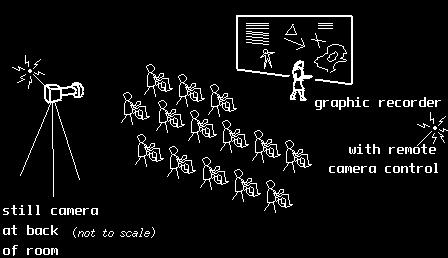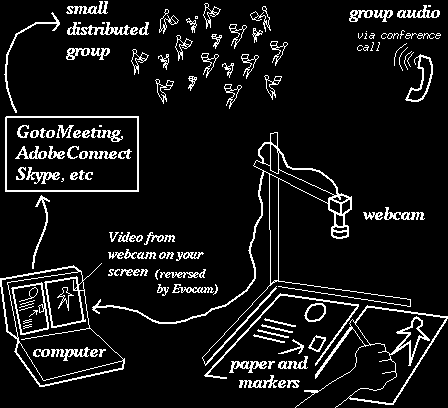
(click here or on image to see full 1024×768 size, make sure browser is stretched wide)
Stark but usable. And, with tweaking, could be good. Further testing needed (note that I was in a hurry, and, frankly I’m just not that good a letterer (erer), even in leisure).
I think graphic recording on the iPad is over the threshhold. At this point in time, not far over, but clearly over. With further tuning of styli and software aimed at our particular needs, it could *really* take off.
Here is a log of my first test, results of which you see above.
5:15pm — Drove South and arrived at my local Apple reseller, Computer Works (who closes at 6:00pm).
5:28pm — Purchased “Pogo Sketch” stylus.
5:35pm — Using *my* iTunes account, purchased SBPro for $7.99 and installed on store’s demo iPad.
5:40pm — Started learning SBPro on iPad, but tutorial taking too long so punted rest of it.
5:45pm — Figured out opacity 1.0 with thinnest line, pencil brush, then started lettering. Hey, not bad, but took getting used to.
5:50pm — Erased first 3 tries, started “final” which you see. Two finger zoom to magnify, then letter, then shrink again worked fine. Seems like a good riff, *even when* a group is watching you work live (or maybe especially when — there’s a lot of showmanship possibilities I think).
5:55pm — Finished, saved pict to SBPro Gallery.
5:58pm — Matt Wilson, sales manager at the store, was kind enough to use his gmail account to send the pict you see (from iPhoto, which can access the Gallery).
THOTS
0. Oops! 4/16/10: apparently VGA out support is on a per-application basis, not simply screen sharing of whatever you see! And apparently SBPro mobile doesn’t have it (yet). I posted the question to the appropriate Autodesk forum. Stay tuned.
1. SBPro save to Gallery to iPhoto to email is clumsy, but worked right out of the box (not how well the elephant does the tango, but that it can at all). Means I could have been in a meeting, whole group seeing graphics via projector, and then the images are available very quickly on the net. I bet with a little scripting and you could have a robot email reader post jpgs automatically to a web page as you sent them …
2. The most disconcerting thing was that the tip hides the line as it “comes out of the pen,” i.e. when first appears on screen. After I learned to trust that the line was there and simply letter by feel, things got better. Trimming the fuzzy tip might help, but presumably it’s as small as possible and still work right now. What would be nice is a transparent capacitive tip — why not?
3. Apparently there is no way of doing text input for SBPro via keyboard, either on this “mobile” version or the desktop one.
4. Don’t get the “Pogo Stylus” I recommended previously. It’s only 3.5″ long, not enuff for the back end to rest in the crook between your thumb and forefinger, which makes a big difference in the feel of the thing as a drawing tool. Instead, get the “Pogo Sketch,” which at 4.25″ is long enuff.
5. Buying SBPro to install on the iPad at the store was cool; once purchased I can then download again at no additional cost and install on my iPad when I get it (said Matt at the store and I believe him). Update 4/16/10 It works. Logged into iTunes on my comuter at home and clicked to buy the app and got the msg “This update is free because you own a previous version of this item.” Note this is *not* like music from iTunes! Pretty un-DRM-like for Apple.
6. With more time, other SBPro features like, I dunno, color and varying line width and airbrushing etc (etc, etc) could be brought to bear.
7. Yes, the amount of information, text plus graphics, that can be fit into one 1024×768 screen is less than optimal. But SBPro seems to support speedy creation of new screens, and agile navigation among existing screens, which somewhat offsets the size limitation of a single screen.
8. For $7.99 plus cost of Pogo Sketch stylus (varies, $10 on Amazon), any of you can run this experiment yourself. Remember, you only have to buy SBPro once (so cool). Requires friendly store staff. Dunno if most Apple stores are that friendly. Mail me results and I’ll try to post them, omnivore at visualraccoon dot com .
============================
http://itunes.apple.com/us/app/sketchbook-pro/id364253478

Content on Visual Raccoon is licensed under a Creative Commons by-nc-sa 3.0 United States License unless otherwise indicated. Comments are property of the commenters.
 (hey, David, I’d like that prototype returned to me if you’re no longer using it 8-)
(hey, David, I’d like that prototype returned to me if you’re no longer using it 8-)







